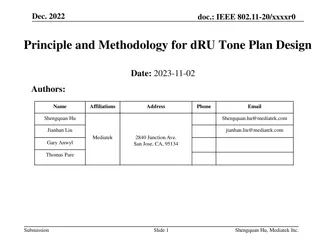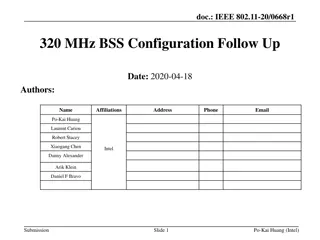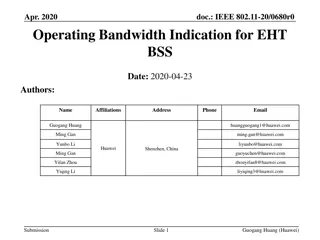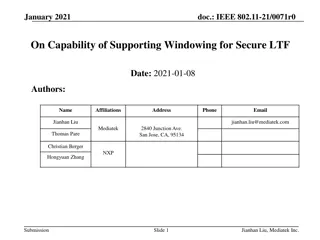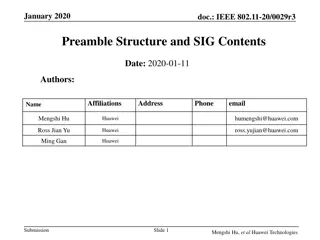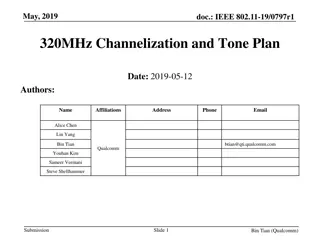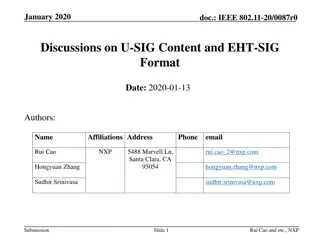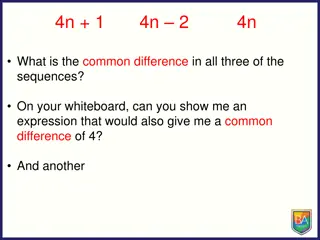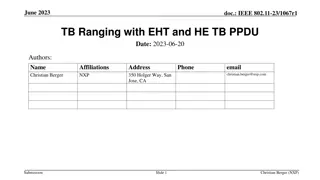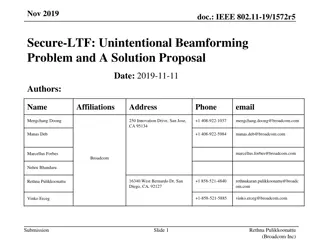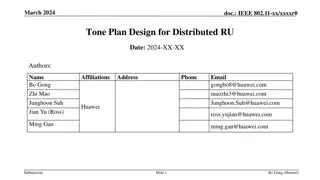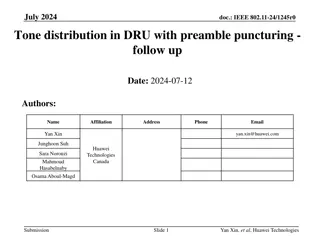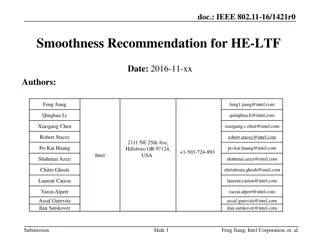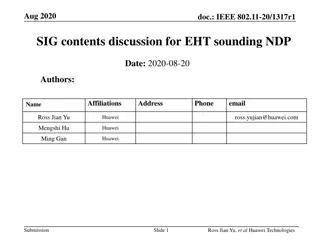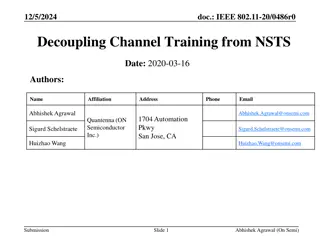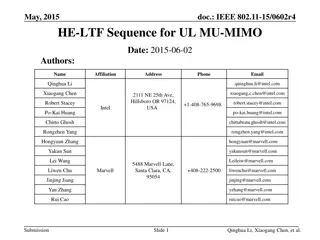
EHT-LTF Sequences Consideration for 320MHz Bandwidth
"Explore the proposal for EHT-LTF sequences in 320MHz bandwidth, including reuse of HE-LTF sequences and PAPR performance evaluation. Suggestions for sequence adjustments and discussions for 240MHz. Detailed analysis and selection process outlined."
Download Presentation

Please find below an Image/Link to download the presentation.
The content on the website is provided AS IS for your information and personal use only. It may not be sold, licensed, or shared on other websites without obtaining consent from the author. If you encounter any issues during the download, it is possible that the publisher has removed the file from their server.
You are allowed to download the files provided on this website for personal or commercial use, subject to the condition that they are used lawfully. All files are the property of their respective owners.
The content on the website is provided AS IS for your information and personal use only. It may not be sold, licensed, or shared on other websites without obtaining consent from the author.
E N D
Presentation Transcript
June 2020 EHT-LTF sequences considering the new tone plan doc.: IEEE 802.11-20/0825r1 Date: 2020-06-08 Authors: Name Affiliation Address Phone Email Jinyoung Chun jiny.chun@lge.com Eunsung Park esung.park@lge.com 19, Yangjae-daero 11gil, Seocho-gu, Seoul 137- 130, Korea LG Electronics Dongguk Lim dongguk.lim@lge.com Jinsoo Choi js.choi@lge.com Submission Slide 1 Jinyoung Chun, LG Electronics
June 2020 doc.: IEEE 802.11-20/0825r1 Introduction I suggested EHT-LTF sequences and the following straw-polls were passed [1]. Do you support to reuse 1/2/4x HE-LTF sequences for 1/2/4x EHT-LTF sequences in 20/40/80MHz? Do you support to reuse 1/2/4x HE-LTF sequences for 1/2/4x EHT-LTF sequences in 80+80/160MHz? I add the PAPR performances of 80/160MHz LTF sequences in new tone plan as a reference in Appendix 1 and 2. And I suggest EHT-LTF sequences for 320MHz. I already suggested the sequences in [1], but I d like to re-check the performance with some changes as [2,3] and re-select the sequences if needed. TBD for 240MHz. That s because we need to discuss first whether we define the LTF sequences alone or use some part of LTF sequences for 320MHz. Submission Slide 2 Jinyoung Chun, LG Electronics
June 2020 doc.: IEEE 802.11-20/0825r1 EHT-LTF sequences for 320MHz BW The suggested 1/2/4x EHT-LTF sequences are as below. EHTLTF320MHz_1x = {LTF80MHz_lower1_1x, 23 zeros, LTF80MHz_upper1_1x, 23 zeros, LTF80MHz_lower2_1x, 23 zeros, LTF80MHz_upper2_1x} LTF80MHz_lower1_1x = {s(1)*LTF80MHz_left_1x, 0, s(2)*LTF80MHz_right_1x} LTF80MHz_upper1_1x = {s(3)*LTF80MHz_left_1x, 0, s(4)*LTF80MHz_right_1x} LTF80MHz_lower2_1x = {s(5)*LTF80MHz_left_1x, 0, s(6)*LTF80MHz_right_1x} LTF80MHz_upper2_1x = {s(7)*LTF80MHz_left_1x, 0, s(8)*LTF80MHz_right_1x} EHTLTF320MHz_2x = {LTF80MHz_lower1_2x, 23 zeros, LTF80MHz_upper1_2x, 23 zeros, LTF80MHz_lower2_2x, 23 zeros, LTF80MHz_upper2_2x} LTF80MHz_lower1_2x = {q(1)*LTF80MHz_part1_2x, q(2)*LTF80MHz_part2_2x, q(3)*LTF80MHz_part3_2x, q(4)*LTF80MHz_part4_2x, q(5)*LTF80MHz_part5_2x} LTF80MHz_upper1_2x = {q(6)*LTF80MHz_part1_2x, q(7)*LTF80MHz_part2_2x, q(8)*LTF80MHz_part3_2x, q(9)*LTF80MHz_part4_2x, q(10)*LTF80MHz_part5_2x} LTF80MHz_lower2_2x = {q(11)*LTF80MHz_part1_2x, q(12)*LTF80MHz_part2_2x, q(13)*LTF80MHz_part3_2x, q(14)*LTF80MHz_part4_2x, q(15)*LTF80MHz_part5_2x} LTF80MHz_upper2_2x = {q(16)*LTF80MHz_part1_2x, q(17)*LTF80MHz_part2_2x, q(18)*LTF80MHz_part3_2x, q(19)*LTF80MHz_part4_2x, q(20)*LTF80MHz_part5_2x} EHTLTF320MHz_4x = {LTF80MHz_lower1_4x, 23 zeros, LTF80MHz_upper1_4x, 23 zeros, LTF80MHz_lower2_4x, 23 zeros, LTF80MHz_upper2_4x} LTF80MHz_lower1_4x = {n(1)*LTF80MHz_left_4x, 0, n(2)*LTF80MHz_right_4x} LTF80MHz_upper1_4x = {n(3)*LTF80MHz_left_4x, 0, n(4)*LTF80MHz_right_4x} LTF80MHz_lower2_4x = {n(5)*LTF80MHz_left_4x, 0, n(6)*LTF80MHz_right_4x} LTF80MHz_upper2_4x = {n(7)*LTF80MHz_left_4x, 0, n(8)*LTF80MHz_right_4x} The sequences are made by changing the signs of each 80MHz_left/right in 1/4x HE-LTF sequences and 80MHz_part1/2/3/4/5 in 2x HE LTF sequence, and picked with PAPR performance in all (M-)RU and punctured cases. Slide 3 Submission Jinyoung Chun, LG Electronics
June 2020 doc.: IEEE 802.11-20/0825r1 Simulation Assumption The best sequences are changed which RUs are considered. Here, I consider the below (M)RUs in 320MHz. 26/52/106/26+52/26+106, 242/484/996/2*996/4*996/3*996/ 3*996+484/ 484+996 in a continuous 160MHz, (2*996+484) I add most of all (M)RU cases in OFDMA or non-OFDMA. All simulation in this contribution is based on 4x sampling with 1stream. Under the situation, the s, q, n for best sequences are as below. There are two options whether (2*996+484)RU are considered or not. The MRU is considered if 240MHz LTF is defined as a part of 320MHz LTF. s(1)~s(8) for 1x LTF = [1 -1 1 1 -1 -1 -1 -1] or [1 -1 -1 -1 1 1 1 1] q(1)~q(20) for 2x LTF = [1 1 1 1 1 1 1 -1 -1 -1 -1 -1 1 -1 -1 -1 -1 1 1 1] or [1 1 -1 -1 -1 -1 -1 - 1 -1 -1 1 1 1 1 1 1 1 1 1 1] n(1)~n(8) for 4x LTF = [1 1 -1 -1 -1 -1 1 1] or [1 1 -1 1 1 1 1 -1] The performance of under 996RU has similar with 80/160MHz. So I show the PAPRs of the suggested LTF sequences in Large RUs (equal or larger than 996RU). See the next page. Submission Slide 4 Jinyoung Chun, LG Electronics
June 2020 doc.: IEEE 802.11-20/0825r1 PAPR performance (1/2) PAPRs in the indices of X-axis 1~4: 996RUs, 5~6: 2*996RUs, 7: 4*996RU, 8~11: 3*996RUs 12~19: (3*996+484)RUs, 20~27: (996+484)RUs, 28~51: (2*996+484)RUs Option 1 of 1/2/4x LTF is to minimize the worst PAPR in all (M)RU cases and, option2 is to minimize the worst PAPR in (M)RU cases except (2*996+484) case. 1x LTF All PAPRs are under the data s. And there s no big difference of PAPRs between two options. (2*996+484) RUs Submission Slide 5 Jinyoung Chun, LG Electronics
June 2020 doc.: IEEE 802.11-20/0825r1 PAPR performance (2/2) 2x LTF All PAPRs of option 1 are under the data s. Option 2 has a highest PAPR in (2*996+484)RUs, but except that, it shows slightly lower PAPR than option1. 4x LTF Any combinations based on HE-LTF can t put all PAPRs under 50% data s. Option1 has minimum value of worst PAPR in all (M)RU cases. Option2 s PAPRs are mostly lower than option 1 except (2*996+484)RUs. [NOTE] It has the similar trend in non-continuous 160+160MHz. Refer Appendix 3. Submission Slide 6 Jinyoung Chun, LG Electronics
June 2020 doc.: IEEE 802.11-20/0825r1 Conclusion In this contribution, I suggest a unified sequence for each 1, 2 and 4x EHT-LTF of 320MHz and checked the PAPR performance considering the new tone plan. The sequences are made by reusing the existing LTF sequences for easy implementation. Based on the method, I suggest two options in each 1/2/4x LTF, and the best sequence can be changed whether 2*996+484 is included or not in 320MHz. Submission Slide 7 Jinyoung Chun, LG Electronics
June 2020 doc.: IEEE 802.11-20/0825r1 Reference [1] IEEE802.11-20/0608r0, Consideration on EHT-LTF [2] IEEE802.11-20/667r1, Small RU Combinations [3] IEEE802.11-20/0608r2, 80MHz OFDMA Tone Plan Submission Slide 8 Jinyoung Chun, LG Electronics
June 2020 doc.: IEEE 802.11-20/0825r1 Straw poll 1 Do you support to use a unified sequence for each 1/2/4x EHT-LTF in non-OFDMA and OFDMA transmission of 320MHz and 160+160MHz BW PPDU? Y/N/Abs Submission Slide 9 Jinyoung Chun, LG Electronics
June 2020 doc.: IEEE 802.11-20/0825r1 Straw poll 2 Do you support to make EHT-LTF sequences by reusing HE-LTF sequences as below in 320MHz BW PPDU of 11be? 80MHz_left/right in 1x and 4x HE-LTF sequence, respectively 80MHz_part1/2/3/4/5 in 2x HE LTF sequence The coefficient of the sequences are changed in 11be. Y/N/Abs Submission Slide 10 Jinyoung Chun, LG Electronics
June 2020 doc.: IEEE 802.11-20/0825r1 Straw poll 3 Which one do you support to be used for EHT-LTF sequences in 240MHz and 160+80MHz BW PPDU? Option1: some parts of EHT-LTF sequences of 320MHz Option2: other sequences for 240MHz and 160+80MHz specific Y/N/Abs Submission Slide 11 Jinyoung Chun, LG Electronics
June 2020 doc.: IEEE 802.11-20/0825r1 Appendix 1. PAPRs of LTF in 80MHz PAPRs in the indices of X-axis. 1~36: 26-tone RUs 37~52: 52-tone RUs 53~60: 106-tone RUs 61~64: 26+52-tone RUs 65~68: 26+106-tone RUs 69~72: 242-tone RUs 73~74: 484-tone RUs 75: 996-tone RUs 76~78: 484+242-tone RUs I omits the center 26 RU of old tone plan to match the indices of old and new tone plan. PAPRs in the new tone plan are shown a little higher than with old tone plan in some cases, but most LTF sequences have lower PAPRs than 50% data except in one or two 26 RUs. But the PAPR is around 6dB and it seems to have no problem. Submission Slide 12 Jinyoung Chun, LG Electronics
June 2020 doc.: IEEE 802.11-20/0825r1 Appendix 2. PAPRs of LTF in 160MHz PAPRs in the indices of X-axis. 1~72: 26-tone RUs 73~104: 52-tone RUs 105~120: 106-tone RUs 121~128: 26+52-tone RUs 129~136: 26+106-tone RUs 137~144: 242-tone RUs 145~148: 484-tone RUs 149~150: 996-tone RUs 151: 2*996 RU 152~155: 484+996 RUs 156~163: 242+484+996-tone RUs I omits the center 26 RU of old tone plan to match the indices of old and new tone plan. It has similar trend with LTF in 80MHz. Submission Slide 13 Jinyoung Chun, LG Electronics
June 2020 doc.: IEEE 802.11-20/0825r1 Appendix 3. PAPRs in 160+160 BW There are no 2*996+484RUs in 160+160MHz. PAPRs in 160+160MHz are not higher than in 320MHz. Submission Slide 14 Jinyoung Chun, LG Electronics


